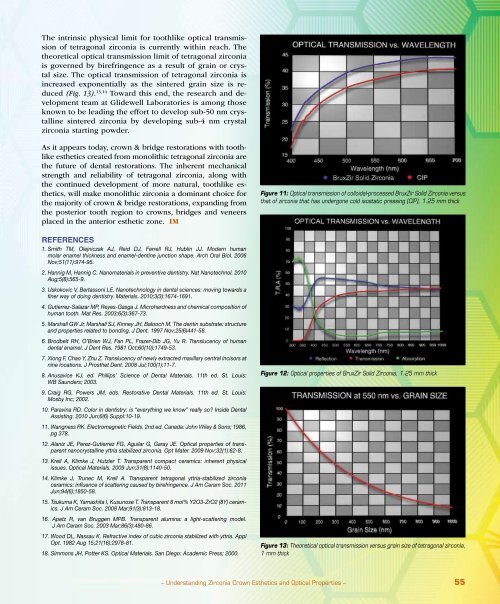PDF Download - Glidewell Dental Labs
PDF Download - Glidewell Dental Labs
PDF Download - Glidewell Dental Labs
You also want an ePaper? Increase the reach of your titles
YUMPU automatically turns print PDFs into web optimized ePapers that Google loves.
The intrinsic physical limit for toothlike optical transmission<br />
of tetragonal zirconia is currently within reach. The<br />
theoretical optical transmission limit of tetragonal zirconia<br />
is governed by birefringence as a result of grain or crystal<br />
size. The optical transmission of tetragonal zirconia is<br />
increased exponentially as the sintered grain size is reduced<br />
(Fig. 13). 13,14 Toward this end, the research and development<br />
team at <strong>Glidewell</strong> Laboratories is among those<br />
known to be leading the effort to develop sub-50 nm crystalline<br />
sintered zirconia by developing sub-4 nm crystal<br />
zirconia starting powder.<br />
As it appears today, crown & bridge restorations with toothlike<br />
esthetics created from monolithic tetragonal zirconia are<br />
the future of dental restorations. The inherent mechanical<br />
strength and reliability of tetragonal zirconia, along with<br />
the continued development of more natural, toothlike esthetics,<br />
will make monolithic zirconia a dominant choice for<br />
the majority of crown & bridge restorations, expanding from<br />
the posterior tooth region to crowns, bridges and veneers<br />
placed in the anterior esthetic zone. IM<br />
References<br />
1. Smith TM, Olejniczak AJ, Reid DJ, Ferrell RJ, Hublin JJ. Modern human<br />
molar enamel thickness and enamel-dentine junction shape. Arch Oral Biol. 2006<br />
Nov;51(11):974-95.<br />
2. Hannig M, Hannig C. Nanomaterials in preventive dentistry. Nat Nanotechnol. 2010<br />
Aug;5(8):565-9.<br />
3. Uskokovic V, Bertassoni LE. Nanotechnology in dental sciences: moving towards a<br />
finer way of doing dentistry. Materials. 2010;3(3):1674-1691.<br />
4. Gutierrez-Salazar MP, Reyes-Gasga J. Microhardness and chemical composition of<br />
human tooth. Mat Res. 2003;6(3):367-73.<br />
5. Marshall GW Jr, Marshall SJ, Kinney JH, Balooch M. The dentin substrate: structure<br />
and properties related to bonding. J Dent. 1997 Nov;25(6)441-58.<br />
6. Brodbelt RH, O’Brien WJ, Fan PL, Frazer-Dib JG, Yu R. Translucency of human<br />
dental enamel. J Dent Res. 1981 Oct;60(10):1749-53.<br />
7. Xiong F, Chao Y, Zhu Z. Translucency of newly extracted maxillary central incisors at<br />
nine locations. J Prosthet Dent. 2008 Jul;100(1):11-7.<br />
8. Anusavice KJ, ed. Phillips’ Science of <strong>Dental</strong> Materials. 11th ed. St. Louis:<br />
WB Saunders; 2003.<br />
9. Craig RG, Powers JM, eds. Restorative <strong>Dental</strong> Materials. 11th ed. St. Louis:<br />
Mosby Inc; 2002.<br />
10. Paravina RD. Color in dentistry: is “everything we know” really so? Inside <strong>Dental</strong><br />
Assisting. 2010 Jun;6(6) Suppl:10-19.<br />
11. Wangness RK. Electromagnetic Fields. 2nd ed. Canada: John Wiley & Sons; 1986,<br />
pg 378.<br />
12. Alaniz JE, Perez-Gutierrez FG, Aguilar G, Garay JE. Optical properties of transparent<br />
nanocrystalline yttria stabilized zirconia. Opt Mater. 2009 Nov;32(1):62-8.<br />
13. Krell A, Klimke J, Hutzler T. Transparent compact ceramics: inherent physical<br />
issues. Optical Materials. 2009 Jun;31(8):1140-50.<br />
14. Klimke J, Trunec M, Krell A. Transparent tetragonal yttria-stabilized zirconia<br />
ceramics: influence of scattering caused by birefringence. J Am Ceram Soc. 2011<br />
Jun;94(6);1850-58.<br />
15. Tsukuma K, Yamashita I, Kusunose T. Transparent 8 mol% Y2O3-ZrO2 (8Y) ceramics.<br />
J Am Ceram Soc. 2008 Mar;91(3):813-18.<br />
16. Apetz R, van Bruggen MPB. Transparent alumina: a light-scattering model.<br />
J Am Ceram Soc. 2003 Mar;86(3):480-86.<br />
17. Wood DL, Nassau K. Refractive index of cubic zirconia stabilized with yttria. Appl<br />
Opt. 1982 Aug 15;21(16):2978-81.<br />
18. Simmons JH, Potter KS. Optical Materials. San Diego: Academic Press; 2000.<br />
Figure 11: Optical transmission of colloidal-processed BruxZir Solid Zirconia versus<br />
that of zirconia that has undergone cold isostatic pressing (CIP), 1.25 mm thick<br />
Figure 12: Optical properties of BruxZir Solid Zirconia, 1.25 mm thick<br />
Figure 13: Theoretical optical transmission versus grain size of tetragonal zirconia,<br />
1 mm thick<br />
– Understanding Zirconia Crown Esthetics and Optical Properties – 55

















